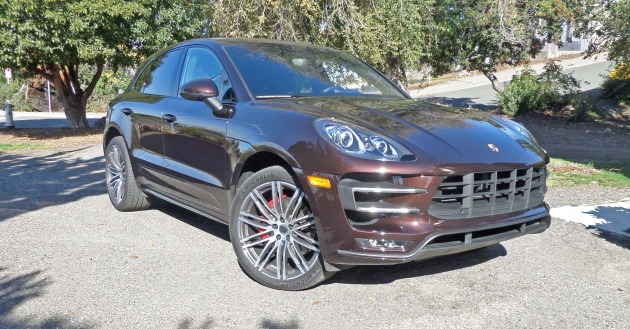2015 Porsche Macan Turbo
Porsche strong player in the compact SUV arena

The 2015 Porsche Macan Turbo is a crossover vehicle that represents the German manufacturer?s fifth model line and the first entry into the compact sports utility vehicle marketplace. The Macan actually bowed in 2013 as a 2014 model. The first Porsche SUV model line came to market as the Porsche Cayenne, and many wondered why Porsche was venturing out of their realm of sports car expertise and into the SUV market. Initially, I was one of those skeptics and failed to grasp the big picture ? increased cash flow from a new revenue source. Without the added infusion of income from the Cayenne model lineup, the development and production of such stellar vehicles as the Carrera GT and near million dollar 918 Spyder Hybrid would not have been possible.
The Porsche Cayenne in its various forms has represented a huge sales success for Porsche, and now for 2015, the Porsche Macan is available in North America in two forms ? the Porsche Macan S and Porsche Macan Turbo.

At first glance, the Porsche Macan Turbo appears to be an unsanforized version of its larger Cayenns sibling. Despite its somewhat smaller footprint, the Macan is still a highly capable Sports SUV. Sales expectations call for moving 50,000 annually of this newest compact Porsche SUV.
The Macan is based on Volkswagen?s MLB platform architecture ? the same platform that Audi?s Q5 SUV is based on. Both the Macan and Q5 are approximately the same size, and both are powered by V-6 engines positioned ahead of the front axle, but the Macan differs from the Q5 with roughly only 20 percent of the parts interchangeable.

The base model Porsche Macan S draws its motive energy from a 3.0-liter, twin-turbo V6 that delivers 340 horses along with 339 pound feet of torque, while the top model Porsche Macan Turbo is powered by a 3.6-liter Twin turbo, 90 degree V6 with Direct Fuel Injection and auto stop/start that cranks out 400 horsepower at 6,000 rpm while generating 406 pound feet of tiorque in a range from 1,350 ? 4,500 rpm. Both the S and the Turbo Macans are all-wheel drive. Look for a less expensive trim model to follow these two initial entries.
Another notable difference between the Macan and Q5 lies in the transmissions ? the Macan employs a seven-speed, dual clutch PDK (Porsche Dopelkupplung) with steering wheel mounted paddle shifters, and the Q5 comes with an eight-speed automatic.
Okay, enough with the comparisons, let?s focus on our test Porsche Macan Turbo which came with a base price of $72,300 that bumped up to $73,295 after adding the Destination and handling charges. My test Macan Turbo wore a rich exterior coat of Mahogany metallic, with the interior executed in Black. Option pricing was not available, but if memory serves me correctly, the Sports Chrono feature adds roughly another $2,500. to the equation. Without a Monroney, I?m not able to factor in all other options. Just guessing, my Turbo as equipped was probably well north of $90,000 and frighteningly into Cayenne territory, since it seemed to be fully loaded with extra goodies such as an upscale stereo system, a Premium Package Plus, optional wheels, and more.

The exterior of the Macan appears remarkably close to that of the Cayenne, but as already mentioned ? on a somewhat smaller scale, which will likely prove to be more suitable to many consumers. An interesting feature is the fact that there are cutouts in the hood for the headlights in much the same fashion as a MINI Cooper.


The interior is well finished with a center console that resembles that of a commercial jet aircraft ? much on the order of the Porsche Panamera ? alittle intimidating at first , but easily mastered. The seats are highly supportive and comfortable.As one would expect, the Macan Turbo?s performance is Porsche through and through. It is totally satisfying to pilot. Forget phenomenal fuel economy ? EPA estimates are 17 mpg city, 23 mpg highway and19 mpg combined, so it?s livable for an SUV.
I was able to cover some challenging, twisty back country roads with lots of elevation changes and came away smiling. The Macan handles exceptionally well and with ease. Think of it not as a compact SUV, but as a slightly oversized luxury sport wagon with all-wheel drive. It is remarkably planted and stable.

The exhaust note from the twin dual exhaust is melodious and actually sounds more like a V8 than a V6. Engaging the Sport and Sport Plus mode buttons on the console allows tuning in the desired level of performance by altering the throttle response, damping and shift mapping, and eamazingmploying the various attributes of the Sport Chronos feature heightens and sharpens things even more.
Simply tapping an Off-Road button raises the suspension up, while firming up the shocks to their stiffest setting, as well as changing throttle response and traction control settings, while transferring more power to the front wheels. The Macan has no low-range four-wheel-drive system, and even though I didn?t have the opportunity to put it through its paces off-pavement, I?m sure that it?s quite capable of serving admirably in light off-road duty.

The Porsche Macan is not inexpensive, especially if you go for the current top-of-the-line Turbo model, equipped to the hilt, and the back seat isn?t very spacious, but would be comfortable for children. What the Macan does, is open up the Porsche experience to an expanded range of consumers, who desire a smaller, more manageable SUV than the Cayenne. And, if its sales are as successful as past Cayenne sales have proven for Porsche, there will be even more resources for R&D, that will likely yield a new crop of amazing future super car examples.

[wptabs style=”wpui-light” effect=”slide” mode=”horizontal”]
?[wptabtitle] SPECIFICATIONS: 2015 Porsche Macan Turbo [/wptabtitle]
?? [wptabcontent]
| Base Price: | $72,300. |
| Price as Tested: | $73,295. |
| Engine Type and Size: | 3.6-liter, Twin turbo, 90 degree V6 with Direct Fuel Injection and auto stop/start. |
| Horsepower (bhp): | 400 @ 6,000 rpm |
| Torque (ft./ lbs.): | 406 @ 1,350-4,500 rpm |
| Transmission: | Seven-speed PDK (Porsche Dopelkupplung) with steering wheel mounted paddle shifters. |
| Drive Train: | Longitudinally mounted front engine / All-wheel drive with electronically controlled, map controlled multi-plate clutch. |
| Suspension: |
Front – Aluminum, 5-arm wishbone axle. Rear – Self-tracking trapezoidal link. |
| Brakes: | Power-assisted four-wheel vented discs with red six-piston fixed calipers in front and a single floating piston in the rear. |
| Tires: | Michelin Latitude Sport 3- 235/55 R19 101 x 8″ front / 255/50 R 18×9″ rear mounted on 10-double-spoke (20) alloy Macan Turbo wheels. |
| Wheelbase: | 110.51 inches |
| Length Overall: | 185.00 inches |
| Width: | 82.60 inches – with mirrors (76.14 without) |
| Height: | 63.35 inches |
| Curb Weight: | 4,652 lbs. |
| Fuel Capacity: | 19.8 gallons |
| EPA Mileage Estimates: | 17 mpg city / 23 mpg highway -19 mpg combined |
| Drag Coefficient: | 0.37 |
| 0 – 60 mph: | 4.4 seconds (4.4 seconds with Sport Chrono package – Top track speed = 164 mph. |
?? [/wptabcontent]
[/wptabs]
 Arv Voss is a Northern California based freelance motoring Journalist and member and past officer of several noted Automotive Journalist organizations who contributes regularly to a number of national and international media outlets. He reviews not only cars, trucks and SUVs, but motorcycles as well.
Arv Voss is a Northern California based freelance motoring Journalist and member and past officer of several noted Automotive Journalist organizations who contributes regularly to a number of national and international media outlets. He reviews not only cars, trucks and SUVs, but motorcycles as well.








